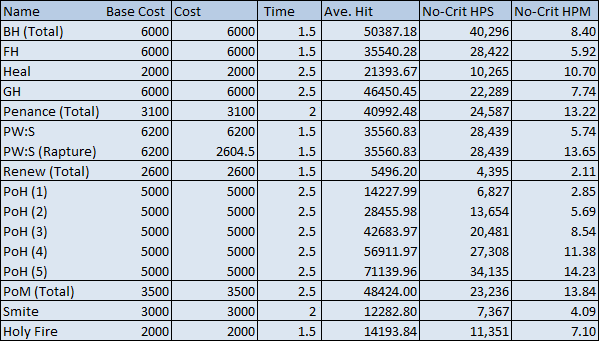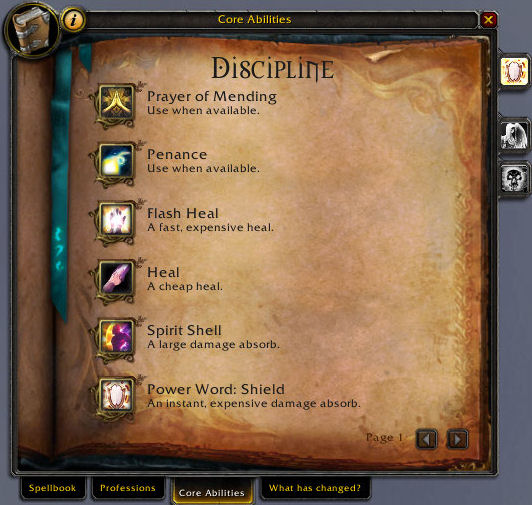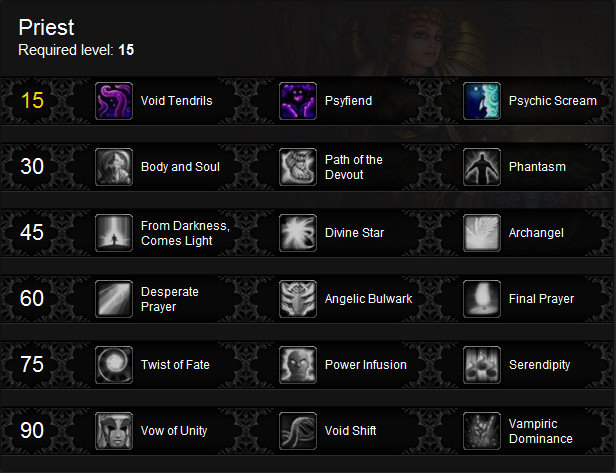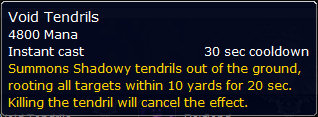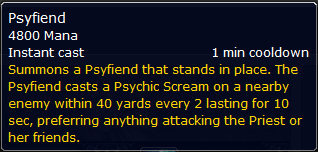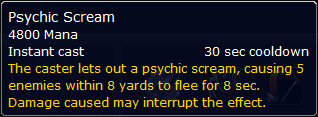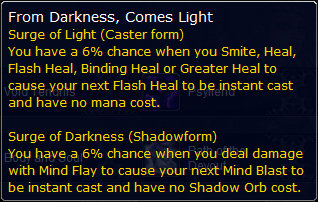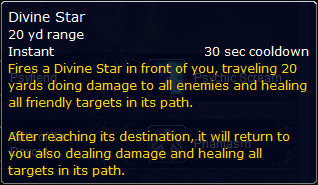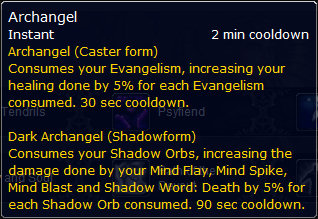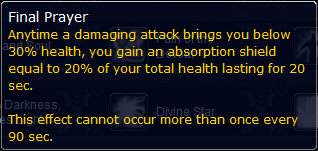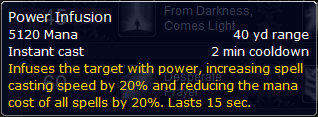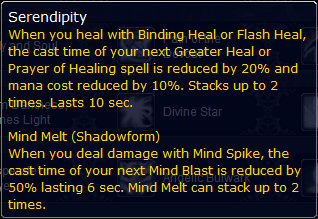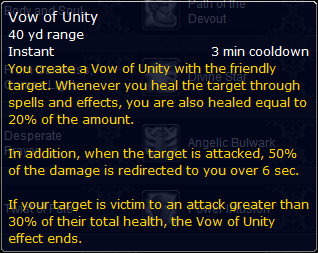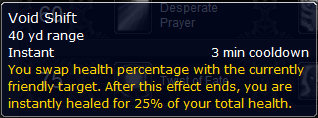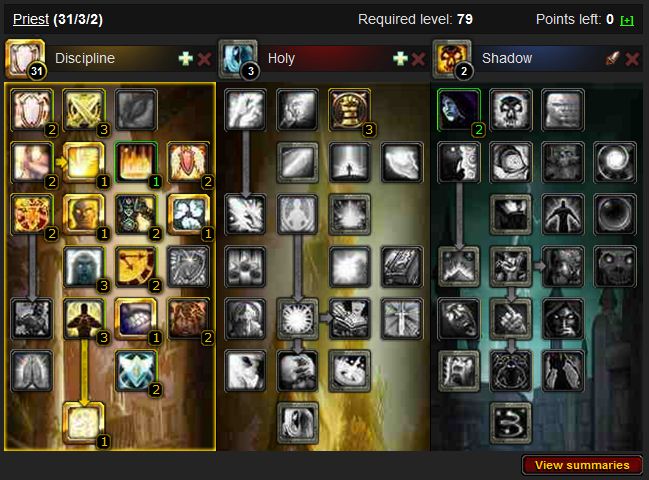
I’ve spent a bit of time in the last week or two playing my Discipline Priest in the Mists of Pandaria beta, and trying to figure out what’s changed and what’s what in the new world order. Of course, this being Beta, it’ll all have changed again next week, so treat this as a snapshot of where things are at. (I actually delayed publishing this until I had time to see the new Spirit Shell changes, more on that below!)
As is my wont this post got a bit long, so if you want to skip to a specific part here’s links to the discussion of spells, their costs and performance, Spirit Shell, Rapture, Talents and Glyphs.
Bear in mind that I’m still only level 86 as I write this, and the experience changes a lot as you level up.
The Gotcha Test
The first thing I do when I log into a beta or PTR is what I think of as the “Gotcha!” test. I take a close look at the HPS, HPM and costs of all our spells. Why? Remember Flash Heal in Wrath? And in Cataclysm? That’s what I’m looking for, a go-to ability that’s undergone a drastic shift. Here’s the list at level 85, at my gear level which is ilvl 404 on Live:
Notice that the mana costs are all nice neat round numbers. That’s because all healers now have a fixed mana pool of 100,000 MP (except gnomes, who have 105,000 MP thanks to our racial!) and spells cost a fixed percentage of our maximum mana.
No huge surprises in there this time, so I won’t go into too much detail. Most of the spells are where they have been in Cataclysm, which is nice. Flash Heal and Power Word: Shield remain our fast, expensive emergency heals. They have pretty punishing HPM and high costs, but they’re quick. Penance is still earning its cooldown with comparable HPS to Flash Heal but half the mana cost, and Prayer of Healing is still good when you have 3 or more people to heal up.
On the subject of abilities, there’s a new page on the spellbook labelled Core Abilities:
This is a helpful little nugget to nudge new players in the right direction when picking up a spec for the first time, or returning to a spec after a while away. It might be nice to draw attention to this tab more obviously, maybe as a tutorial tip, because it’s not even in the Talents window so you could easily overlook it.
Spirit Shell
While for a while Spirit Shell was an absorb replacement for Greater Heal, that design was rolled back in a recent build in favour of giving us GH back and redesigning Spirit Shell. Personally, I like what they’ve done with the spell.
Spirit Shell is a 15s self-buff on a 1 minute cooldown that turns all the heals you cast into absorbs with their own 15s duration. According to Ghostcrawler it’s been designed to take account of Divine Aegis (by increasing the size of the bubble by your crit chance so if, for example, you have 20% crit chance your bubble will be 120% of the size of the heal), the bubble size benefits from Grace in the same way the original heals would, and the bubbles also scale with Mastery. Note that the bubbles don’t “crit”, your crit chance has already been taken into account.
To put some numbers on this, imagine you hit Spirit Shell, then cast Greater Heal on your tank. Suppose, for the sake of argument, a baseline Greater Heal is good for 50,000 HP.
I have 15% crit chance, so that gives me a bubble of 50,000 * 1.15 = 57,500 HP.
I also have 25.73% stronger bubbles from Mastery, which takes my bubble up to 57,500 * 1.2573 = 72,295 HP.
Add in a triple-stacked Grace for a 30% boost, and my Greater Heal bubble is up to a whopping 72,295 * 1.30 = 93,983 HP.
That’s good stuff!
The current implementation is still a little early. Currently it’s not actually benefiting from any of those extra effects so we’re stuck with the basic heal. There’s also the open question, which Ghostcrawler acknowledged is still one they don’t have an answer for, of how stacking and capping these bubbles will work. Currently the Spirit Shell shields from different heals stack with each other (they create separate buffs for themselves depending on the spell) but casting the same spell twice refreshes the duration but replaces the absorb amount with the latest value, even if it’s lower.
I expect both of these behaviours to change and I wouldn’t be surprised to see the effect end up working more like DA does, where all the heals contribute to a single bubble buff which stacks up to a cap. The developers did point out that they don’t like us feeling like we need to spam something up to a cap (PoH/DA, anyone?), but I don’t think I mind that sort of mechanic. We’ll have to see how it plays out.
The utility of this is centred around preparing for and preventing damage. Know the Elementium Bolt is about to splash down, or your tank’s going to get Impaled? Get those bubbles out there to take the edge off it. The fact that it scales with Mastery means that you’ll get a slight healing boost out of this cooldown as well (Mastery affects the whole bubble, rather than just the DA portion of the heal), but the tradeoff if that you’ll have to have enough damage coming out to take proper advantage of the absorbs.
Rapture
Rapture is something of a vexed subject at the moment.
Rapture, on Beta and on Live, returns a lump of mana when your PW:S breaks; on Live it’s a fraction of your total mana, on the Beta it’s 150% of your Spirit. On Live this is (significantly) more than the PW:S cost to cast, making it an important source of mana regeneration, whereas on Beta the return is less than the cost of PW:S.
If we consider Rapture as a regeneration mechanic, it’s a slightly problematic one. The objections been gone over several times, including in the links above, but they more or less come down to difficulties in getting PW:S to break reliably when the damage is light or unpredictable or cases where you have multiple Disc Priests fighting over opportunities to bubble a single tank.
This unreliability is a problem on Live because Rapture is a form of “active mana regeneration”, like a potion on a 12s cooldown, and it’s a major part of our mana equation – we cast a bubble every 12 seconds to give us the mana we need to do whatever it is we actually want to be doing – and because it’s so powerful we don’t bother with Spirit for the most part. Imagine if your Shadowfiend had a 50% miss chance, or your Hymn of Hope didn’t actually give you any mana back half the time. Oh, wait…
However, Ghostcrawler explained that that this wasn’t actually the intention of Rapture:
Rapture isn’t trying to be Telluric Currents. You shouldn’t spam PW:Shield when you need mana. Rapture is intended to offset the cost of PW:Shield when the latter is used intelligently.
So instead of thinking of Rapture as part of our mana regeneration, instead we should think of it as a discount on casting PW:S as long as we don’t do it too often and pick a target that’s actually going to take damage. Think of it as a proc like Surge of Light, giving us a cheap PW:S every now and then instead of a free Flash Heal, only it doesn’t proc randomly but activates every 12 seconds instead. I still think there’s a possible issue with PW:S needing to break, especially in the case where you have two Disc Priests fighting over the damage, but you can at least see why that design is there, and that might be an application of the Divine Insight talent (call-ahead!).
Have a look back at the table, and look at the HPS and HPM of PW:S with and without Rapture. Without Rapture it’s still our best HPS ability, but the cost is punishing. Factor in a Rapture proc though and it’s suddenly right up there with our best HPM abilities as well.
There’s still one small wrinkle though, and that’s Meditation. You see, Meditation for Disc Priests is 25%, whereas it’s 50% for every other healing spec. The reason for this is that because Rapture makes PW:S so cheap and so powerful (when we weave it in) we can achieve the same output as the other specs for a smaller mana cost. To balance out this lower cost, our background regen is lowered to match.
The upshot is that if we don’t use PW:S at all, or don’t use it especially intelligently, we’ll end up a little behind the other specs mana-wise. If we use it exceptionally well, we’ll potentially end up ahead. Now the ball’s in Blizzard’s court, and they’ll need to tweak the numbers as the Beta progresses and we hit the level 90 content to make sure we’re balanced.
Talents
I’ve not done a talent run-down in a while, so let’s see where we’re at with those.
Level 15
Level 15 remains the “CC” tier. Void Tendrils summons a Tendril for every mob within 8 yards of you that roots it for up to 20 seconds; Psyfiend lets you spawn a Psyfiend at a location you choose that fears a mob attacking you every 1.5s; Dominate Mind is Mind Control. Videos of the first two are below for your enjoyment.
Void Tendrils:
Psyfiend:
Personally I’d go with Void Tendrils as my standard pick, just because fear is often a risky proposition. But I can see a lot of value in the Psyfiend in PvP. Throw it down on a flag or into a tower and watch the fun, or maybe just use it to keep people off you.
Level 30
At Level 30 you’ve got the movement talents. Body and Soul is the same ability we’ve known and envied for two expansions, only now it’s available to all Priests regardless of spec. The contender for PvE is Angelic Feather, which lets you place up to 3 feathers on the ground that grant a movement speed boost to the next person to step on them. If you have a known kite patch or need to keep someone moving at speed for a while then Angelic Feather is stronger than Body and Soul, but Body and Soul is more flexible if you just need to get someone moving and don’t necessarily know who it’s going to be. Tailor your choice to the situaion.
Phantasm looks at first glance like more of a PvP choice, although don’t rule it out entirely for PvE either. It makes your Fade remove all movement-impairing effects and makes you untargetable by ranged attacks and immune to movement-impairing effects for 3 seconds. The untargetability might have niche applications (I wonder if it would make you immune to Shrapnel, for example) but the freedom of movement could be handier.
I suspect the choice will usually be between Angelic Feather and Body and Soul for PvE, but it’s nice to have the option of Phantasm as well.
Level 45
Level 45 is the first tier where you get to actually improve your output. From Darkness, Comes Light (FD,CL), which still has that extraneous and slightly grating comma, gives you a 15% chance to proc a free, instant Flash Heal when you use (most of) your single-target heals. The list includes Smite, but not Penance or Holy Fire; this may change, I’d certainly expect to see Penance in that list. Given the high HPS of Flash Heal, this is a strong talent if you’re using a good number of single-target heals.
Mindbender replaces your Shadowfiend and deals double the damage and gives back double the mana. Because everything scales off base mana and base mana is fixed, your Mindbender will return 72% of your mana bar (assuming he doesn’t miss) compared to 36% for the Shadowfiend. This extra mana allows you to use more of the expensive spells, and is a great choice if you don’t think you’ll see the benefit of FD,CL, if you’re AoE healing, for example.
And finally we have Archangel, another old friends that’s been opened up to all three specs. This is a straight up output boost for 18s on a 30s cooldown, assuming you’re able to weave in the requisite number of Smites, Holy Fires and Penances to stack Evangelism up to 5. That’s right: Penance stacks Evangelism now, one stack per tick, and causes Atonement heals as well, so you shouldn’t have any trouble getting Evangelism stacked.
In this tier you’re picking what you need. The first two are all about efficiency, the third is about simple output. I suspect we’ll shift from the left to the right as the expansion progresses and mana becomes less of an issue, and at the start we’ll be interested mostly in FD,CL for tank healing and Mindbender for raid healing, although I’ll admit I’ve not sat down and worked through them in detail yet.
Level 60
Level 60 is all about taking care of yourself. You get a choice of an instant 30% self-heal on a 2-minute cooldown (Desperate Prayer), a shield for 20% of your HP when you’re damaged below 30% of your health every 90s (Angelic Bulwark) and the new Spectral Guise.
Spectral Guise is an interesting talent. When you hit it you spawn a clone of yourself which your enemies will attack, while you get stealthed for 6 seconds or until your clone (“your true form”) is hit 3 times. You can either use the time to run away or to throw a couple of heals on yourself unimpeded.
Spectral Guise feels more solo- or PvP-orientated than the other two since you don’t often take direct attacks as a healer in raids, but it may be useful to save you from a powerful attack directed your way (again Shrapnel comes to mind), since you don’t share in the the damage your clone takes.
Level 75
Here’s where things get really weird, with a jumble of talents. Twist of Fate gives you a 15% damage or healing buff after damaging or healing a target under 20% HP. I can see this possible being useful for handling low-health enrage phases: throw a HF on the boss at 19% and enjoy 15% extra healing for a while, as well as the more orthodox behaviour of rewarding triage-style healing of the lowest people when the raid is weakened.
Alternatively you could go for Power Infusion for 20% faster, 20% cheaper spell for 15s every 2 minutes either for you or for a friend.
The real wildcard is Divine Insight. For Disc Priests this procs from Penance casts and allows your next PW:S to ignore and to not cause Weakened Soul.
I can see two main uses for this. It’d be pretty handy if you needed a quick throughput boost on a single target because it would let you to throw out a PW:S, Penance, PW:S combination, and it would also be useful to let you maximise the frequency of your Rapture-cheapened PW:S casts even if you or another Priest has already got Weakened Soul on your target.
Level 90
Until we’re able to actually play with these all we can do is speculate. I’ll link the three options, but reserve comment until they’re opened up on the Beta.
Your choice at level 90 is between:
Cascade, Divine Star, and Halo.
Glyphs
Since the Prime Glyphs have been removed, we’re left with the utility-focused Major Glyphs and the cosmetic Minor Glyphs.
The minors are all more or less unchanged. Shadow Protection went away with the removal of spell resistances, and we got Glyph of the Heavens instead. This one makes your Levitate targets appear to be floating on a cloud. Funky!
As for Majors, a lot are unchanged, but there are a few interesting changes.
- Glyph of Dispel Magic – Deals damage when you dispel an enemy, rather than healing when you dispel a friendly.
- Glyph of Purify – Heals 3% of max HP when you dispel a friendly. Dispel Magic is now our offensive dispel, while Purify is our defensive dispel/cleanse ability.
- Glyph of Fade – Reduces all damage taken by 10% when you Fade, which could be mighty handy.
- Glyph of Holy Fire – Makes Holy Fire instant-cast. Doesn’t save you any time if you’re able to stand still, but could add a valuable extra tool to our healing-on-the-run toolkit.
- Glyph of Levitate – Increases your movement speed by 10% while you’re levitating and for 10s afterwards.
- Glyph of Penance – Allows you to cast Penance while moving, but increases the cost of Penance by 20%. If you need healing on the run this is a good bet. The cost just stops it from being a no-brainer.
- Glyph of Power Word: Shield – Similar to the old version, but where the healing used to be a bonus, this time the healing is taken out of the absorb instead.




